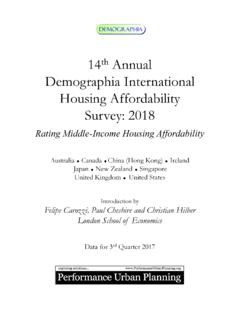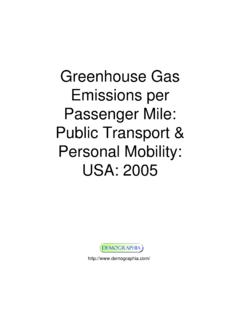Transcription of Demographia World Urban Areas
1 Demographia World Urban Areas 13th Annual Edition: 2017:04. Demographia World Urban Areas . (Built Up Urban Areas or World Agglomerations). 13th ANNUAL EDITION. April p 2017. TABLE OF CONTENTS. Demographia World Urban Areas (Introduction) 1. Urban area LISTINGS. Table 1: Largest Urban Areas in the World 18. Table 2: Urban Areas by Land area ( Urban Footprint) 35. Table 3: Urban Areas by Urban Population Density 53. Table 4: Urban Areas by Geography (Including Selected under 500,000 Population) 71. SUMMARY TABLE. Table 5: Summary: Urban Areas Over 500,000 112. COVER PHOTOGRAPH. Dhaka: Farmgate g ((byy author)). worldua Copyright Notice All rights reserved Permission granted to copy or republish only without alteration of any data, name of Urban area or geography.
2 `. Demographia World Urban Areas (Built-Up Urban Areas or Urban Agglomerations). 13th Annual Edition: April 2017. INTRODUCTION. CONTENTS OF THE INTRODUCTION. RELATED PUBLICATIONS. 1. Demographia World Urban Areas Toward More Prosperous Cities: 2. Important Revisions Framing Essay on Urban Policy 3. Distribution of Population 13th Annual Demographia international 4. Built-Up Urban Areas : Definitional Issues Housing Affordability Survey 5. Smaller Urban Areas (Under 500,000 Population). 6. Geographical Notes 7. Methodology 8. Caution: Trend Analysis 9. Cover Illustration: Farmgate, Dhaka The Evolving Urban Form 10. Comments and Suggestions (Profiles of World Urban Areas ). A Question of Values: Middle-Income Housing Affordability and Urban Containment Policy 1.
3 Demographia World Urban Areas . City Sector Model ( Urban Core & Suburban Small area Analysis Demographia World Urban Areas (Built-up Urban Areas or within US Metropolitan Areas Urban Agglomerations) is the only annually published inventory of population, corresponding land area and population density for Urban Areas with more than 500,000 population. Unlike metropolitan area lists, Demographia World Urban Areas applies a generally consistent definition to built-up Urban Areas . 1 Urban footprint data is reported without regard political boundaries that are generally associated with metropolitan Areas or sub-national jurisdictions. This report contains population, land area and population density for all 1,040 identified built-up Urban Areas ( Urban agglomerations or urbanized Areas ) in the World with 500,000 or more population.)
4 The total population of these Urban Areas is estimated at billion, 53 percent of the World Urban population in 2017. 2. A number of smaller Urban Areas are also listed. Overall, data is provided for 1,746 Urban Areas of all sizes, which comprise a population of billion people, 57 percent of the World Urban population. 1. Other regularly published Urban agglomeration lists do not contain consistently defined entities. They tend to mix metropolitan Areas , municipalities (parts of metropolitan Areas ) and Urban Areas (built up Urban Areas or agglomerations). None of these lists include Urban land area data. The United Nations list is unique in providing notes that clarify the nature of its each of its listings (core cities, metropolitan Areas , Urban Areas and others).
5 2. Calculated using United Nations data. Demographia World Urban Areas 13th Annual Edition ( ) 1. 2. IMPORTANT REVISIONS. 2017 Revisions New census data and estimates as well as later satellite imagery has led to some substantial revisions in the 2016 edition of Demographia World Urban Areas . The most notable are indicated below: Canada has revised its method for delineation of built-up Urban Areas (population centres). Urban Areas are now comprised of qualifying small area blocks, rather than the former municipalities. Some municipalities included large tracts of rural land and this revision removed these Areas from the Urban Areas . As a result, Urban area densities in Canada are higher and land Areas smaller. New local population estimates are available for some larger municipalities (prefectures) in China and have been used to calculate new population bases.
6 Almost without exception, population growth has been well below United Nations projected levels since the 2010 census. Population estimates for built-up Urban Areas with base years before 2013 are likely to be high, because newer estimates may show slower growth rates The adjacent Shenyang and Fushun (Liaoning, China) Urban Areas have been combined. The built-up Urban Areas of Boston and Providence (USA) and other smaller adjacent built-up Urban Areas have been combined as a result of their now being included in the Boston combined statistical area . Earlier Revisions There were important revisions tithe 2016 edition of Demographia World Urban Areas . The most notable are indicated below: Demographia World Urban Areas is now using the Africapolis population and Urban land area data were available, considering them to be the closest approximation to national census data on built- up Urban Areas .
7 Africapolis data covers West African nations and most importantly, appears to provide reliable data on the built-up Urban Areas of Nigeria, where official data has often been challenged. The availability of the Africapolis data makes it unnecessary for Demographia World Urban Areas to develop independent built-up Urban area data in West Africa outside Nigeria, where no difficulty in census data is indicated. The Mumbai built-up Urban area has been expanded to incorporate the Bhiwandi, Kalyan and Vasai-Virar Urban Areas . This is generally consistent with the definition of the Census of India, with the exception that Demographia includes Bhiwandi. A new estimate for Kinshasa has been developed, from 2014 data provided by the Institut National de la Statistique of the Democratic Republic of the Congo (DRC).
8 The data was not sufficient, however, to develop revised estimates for other built-up Urban Areas in the DRC. Demographia World Urban Areas 13th Annual Edition ( ) 2. A new population census ends more than 30 years since the last in Myanmar. Built-up Urban area estimates have been updated using this information. The lower range population estimates for the Lagos built up Urban area have been largely confirmed by the Africapolis project (see Geographical Notes, below). There has been considerable controversy about the population of Lagos for years and local governments had claimed the census of Nigeria had severely under-counted its population. The new information is generally consistent with the Nigerian federal government population data.
9 A new Urban area of more than 5,000,000 residents has been identified by Africapolis, Onitsha, Nigeria. Later local government population estimates in China indicate a slowing of population growth. Revised Format Tables have been simplified and reorganized starting in 2016. The population base, base year and estimates for built-up Urban Areas with less than 500,000 population are shown in Table 4 only. Table 4. contains all Urban Areas covered, in alphabetical order by geography and built-up Urban area name. 3. DISTRIBUTION OF POPULATION (BY Urban area SIZE, Urban DENSITY AND CONTINENT). In recent years, the World has become more than one-half Urban for the first time in history ( percent in 2017). Yet, it would be a mistake to believe that the World 's Urban residents live in settings similar to 5th Avenue in New York or within the fourth ring road of Beijing or in inner Paris, or for that matter in large Urban Areas .
10 Even in Urban settings that are not particularly dense, such as suburban Areas . Further, more than 70 percent of the World 's population lives in Urban Areas with less than 500,000 residents3 or in rural Areas (See: What is a Half- Urban World ? 4). Less than 30 percent ( percent) lives in Urban Areas with 500,000 or more population. 5 More than 70. percent of the World 's population lives outside Urban Areas with 500,000 or more residents (Figure 1). 6. 3. The of Urban Areas under 500,000 is estimated by applying ratios from, Making Room for a Planet of Cities (Shlomo Angel, with Jason Parent, Daniel L. Civco, and Alejandro M. Blei) to the Demographia data. 4. Wendell Cox (2012), "What is a Half- Urban World ," The New Geography, 5.




